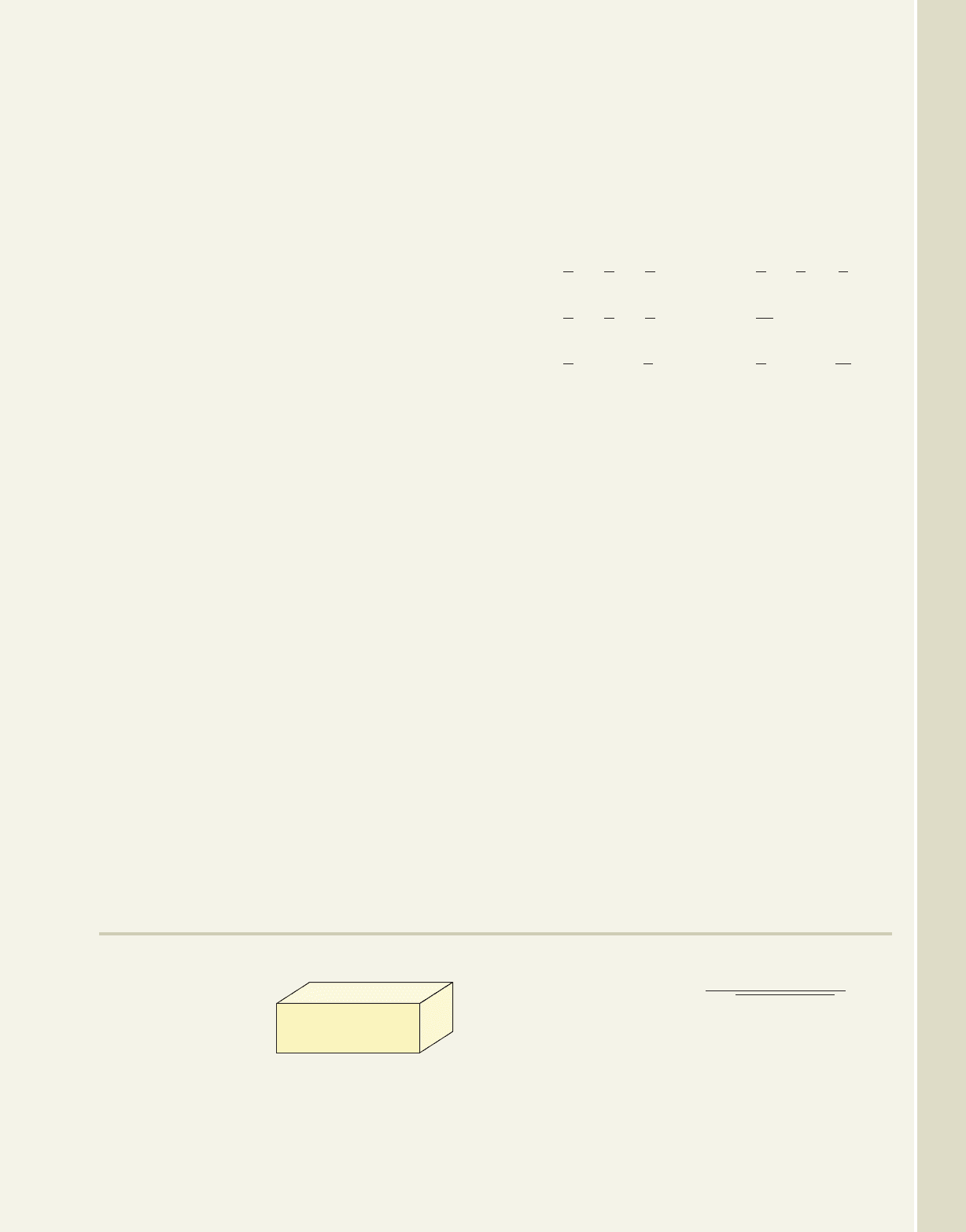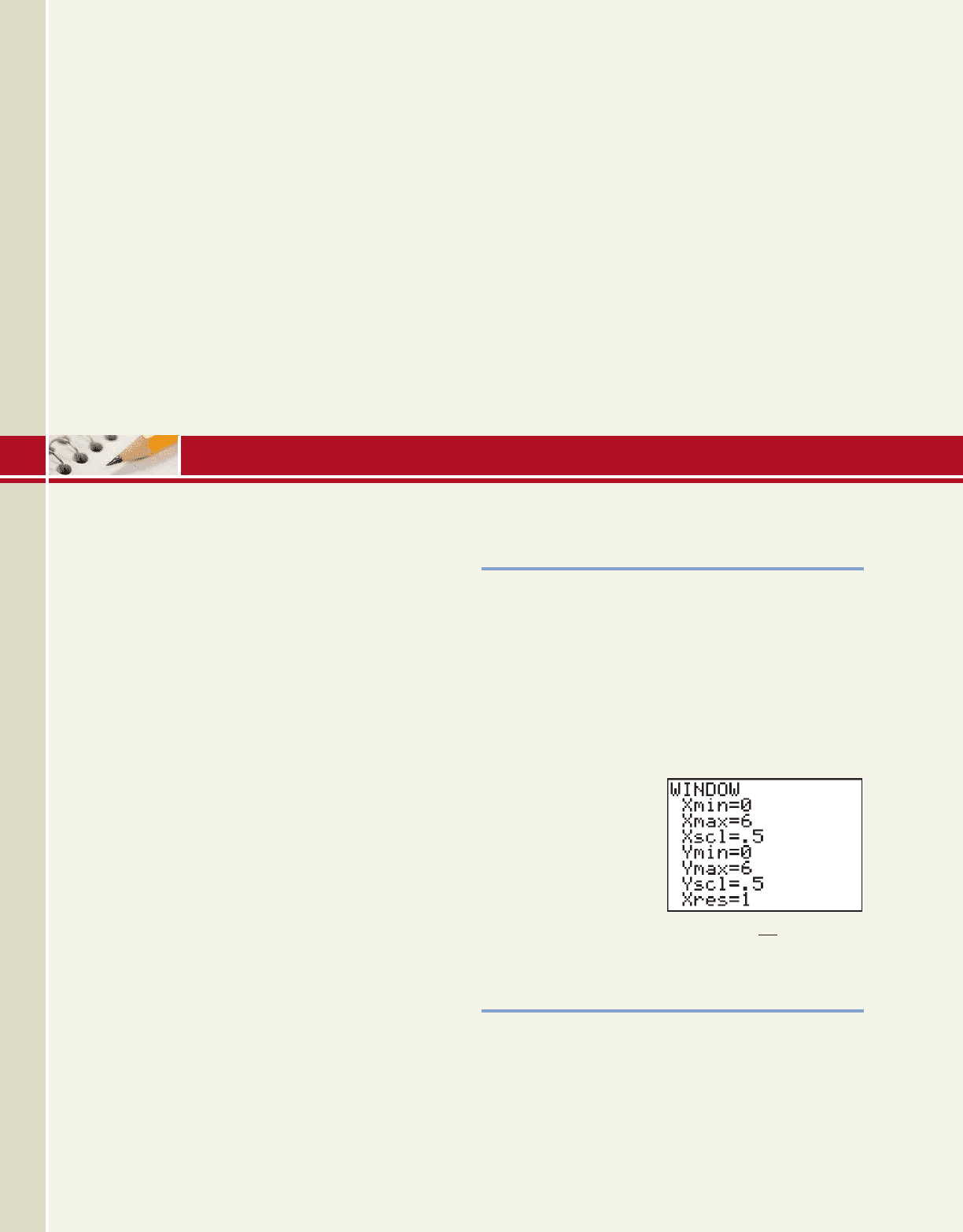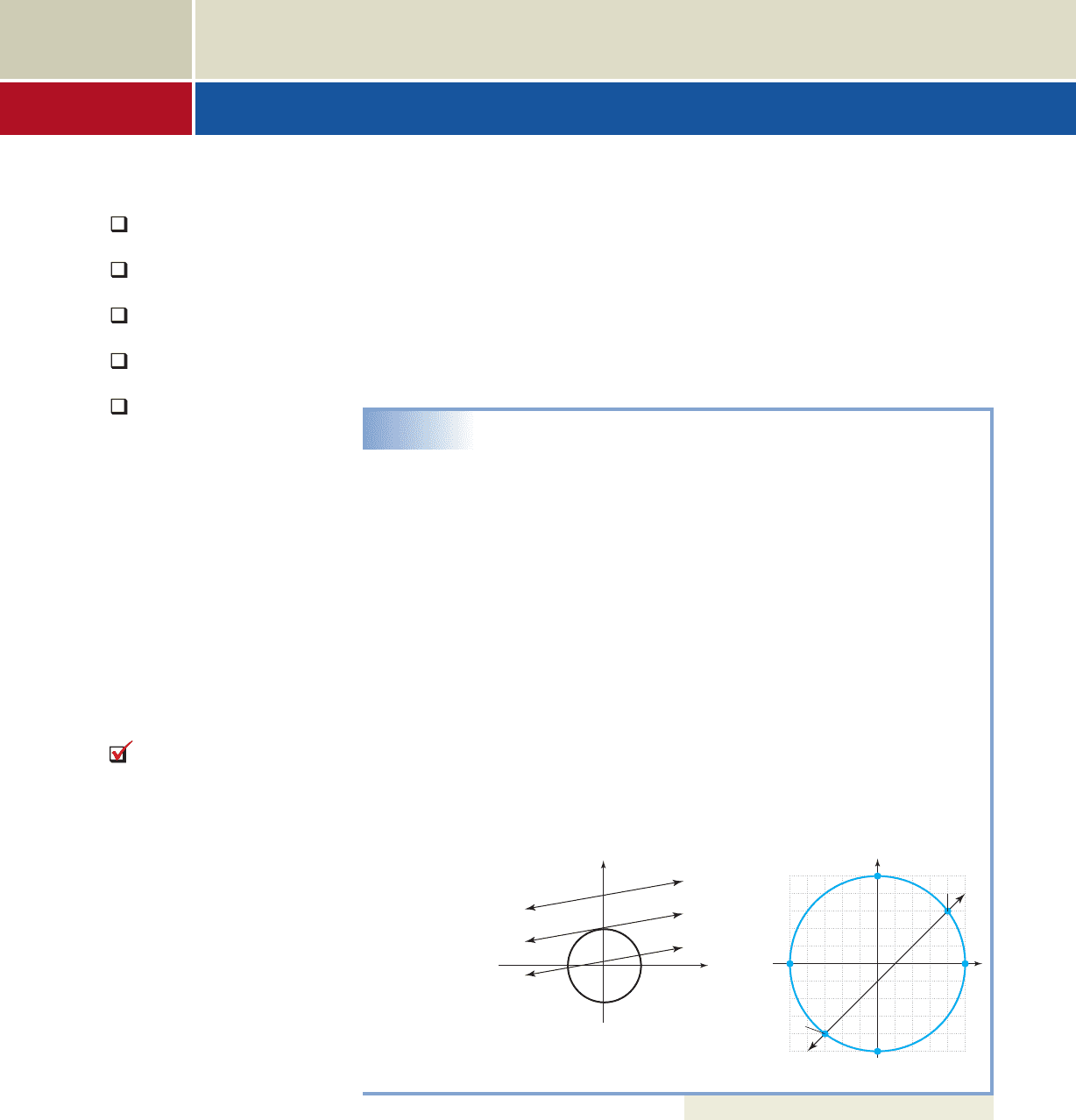Coburn J.W. Algebra and Trigonometry
Подождите немного. Документ загружается.


810 CHAPTER 8 Systems of Equations and Inequalities 8-18
EXAMPLE 4
Solving a System of Three Equations in Three Variables
Solve using elimination:
Solution
1. Write the equations in standard form:
2.
3. Using will eliminate the x-term from R2, yielding
Using eliminates the x-term from R3, yielding
4. Using will eliminate z from the subsystem, leaving
Solving for y in R3 shows Substituting 2 for y in R2 yields and
substituting 2 for y and 4 for z in R1 shows The solution is (3, 2, 4).
Now try Exercises 19 through 24
D. Inconsistent and Dependent Systems
As mentioned, it is possible for larger systems to have no solutions or an infinite
number of solutions. As with our work in Section 8.1, an inconsistent system (no solu-
tions) will produce inconsistent results, ending with a statement such as or
some other contradiction.
EXAMPLE 5
Attempting to Solve an Inconsistent System
Solve using elimination:
Solution
1. This system has no equation where the coefficient of x is 1.
2. We can still use R1 to begin the solution process, but this time we’ll use the
variable y since it does have coefficient 1.
Using eliminates the y-term from R2, leaving But
using to eliminate the y-term from R3 results in a contradiction:
We conclude the system is inconsistent. The answer is the empty set and we
need work no further.
Now try Exercises 25 and 26
,
4x 2y 6z 6
4x 2y 6z 7
0x 0y 0z 1
0 1
2R1
R3
4x 2y 6z 6
3x 2y 4z 2
7x 2z 4
2R1
R2
2R1 R3
7x 2z 4.2R1 R2
•
2x y 3z 3
3x 2y 4z 2
4x 2y 6z 7
.
0 3
x 3.
z 4,y 2.
•
x 3y z 5
5y 2z 18
11y z 18
2R3 R2 S R3
•
x 3y z 5
5y 2z 18
27y 54
27y 54.2R3 R2
•
x 3y z 5
x 2y 3z 13
2x 5y z 8
R1 R2 S R2
2R1 R3 S R3
•
x 3y z 5
5y 2z 18
11y z 18
11y z 18.2R1 R3
5y 2z 18.R1 R2
•
2x 5y z 8
x 2y 3z 13
x 3y z 5
R3 4 R1
•
x 3y z 5
x 2y 3z 13
2x 5y z 8
•
2x 5y z 8
x 2y 3z 13
x 3y z 5
•
5y 2x z 8
x 3z 2y 13
z 3y x 5
.
equivalent
system
equivalent
system
equivalent
system
C. You’ve learned just how
to solve linear systems in
three variables
contradiction
S
S
S
College Algebra & Trignometry—
cob19529_ch08_806-819.qxd 12/30/08 22:29 Page 810

8-19 Section 8.2 Linear Systems in Three Variables with Applications 811
Unlike our work with systems having only two variables, systems in three vari-
ables can have two forms of dependence—linear dependence or coincident depend-
ence. To help understand linear dependence, consider a system of two equations in
three variables: Each of these equations represents a plane,
and unless the planes are parallel, their intersection will be a line (see Figure 8.5). As
in Section 8.1, we can state solutions to a dependent system using set notation with two
of the variables written in terms of the third, or as an ordered triple using a parameter.
The relationships named can then be used to generate specific solutions to the system.
Systems with two equations and two variables or three equations and three vari-
ables are called square systems, meaning there are exactly as many equations as there
are variables. A system of linear equations cannot have a unique solution unless there
are at least as many equations as there are variables in the system.
EXAMPLE 6
Solving a Dependent System
Solve using elimination:
Solution
Using eliminates the y-term from R2, yielding This means
(x, y, z) will satisfy both equations only when (the x-coordinate must be
4 less than the z-coordinate). Since x is written in terms of z, we substitute
for x in either equation to find how y is related to z. Using R2 we have:
which yields (verify). This means the
y-coordinate of the solution must be 1 less than z. In set notation the solution is
. For 0, and 3, the solutions
would be , respectively. Verify that these
satisfy both equations. Using p as our parameter, the solution could be written
in parameterized form.
Now try Exercises 27 through 30
The system in Example 6 was nonsquare, and we knew ahead of time the system
would be dependent. The system in Example 7 is square, but only by applying the elim-
ination process can we determine the nature of its solution(s).
EXAMPLE 7
Solving a Dependent System
Solve using elimination:
Solution
This system has no equation where the coefficient of x is 1. We will still use R1,
but we’ll try to eliminate z in R2 (there is no z-term in R3).
Using eliminates the z-term from R2, yielding
We next solve the subsystem. Using eliminates the y-term in R3, but
also all other terms:
10x 2y 8
10x 2y
8
0x 0y 0
0 0
2R2
R3
2R2 R3
•
3x 2y z 1
2x y z 5
10x 2y 8
R1 R2 S R2
R3 S R3
•
3x 2y z 1
5x y 4
10x 2y 8
5x y 4.R1 R2
•
3x 2y z 1
2x y z 5
10x 2y 8
.
1p 4, p 1, p2
16, 3, 22, 14, 1, 02, and 11, 2, 32
z 2,
51x, y, z,2 | x z 4, y z 1, z 6
y z 11z 42 3y 2z 1,
z 4
x z 4
x z 4.R1 R2
e
2x 3y z 5
x 3y 2z 1
.
e
2x 3y z 5
x 3y 2z 1
.
sum
result
S
College Algebra & Trignometry—
cob19529_ch08_793-846.qxd 11/28/08 15:55 Page 811

812 CHAPTER 8 Systems of Equations and Inequalities 8-20
Since R3 is the same as 2R2, the system is linearly dependent and equivalent to
We can solve for y in R2 to write y in terms of x:
Substituting for y in R1 enables us to also write z in terms of x:
R1
substitute for y
distribute
simplify
solve for z
The solution set is Three of the infinite
number of solutions are for for
Verify these triples satisfy all three equations. Again
using the parameter p, the solution could be written as in
parameterized form.
Now try Exercises 31 through 34
Solutions to linearly dependent systems can actually be written in terms of either
x, y, or z, depending on which variable is eliminated in the first step and the variable
we elect to solve for afterward.
For coincident dependence the equations in a system differ by only a constant
multiple. After applying the elimination process—all variables are eliminated from the
other equations, leaving statements that are always true (such as or some other).
See Exercises 35 and 36. For additional practice solving various kinds of systems, see
Exercises 37 to 51.
E. Applications
Applications of larger systems are simply an extension of our work with systems of two
equations in two variables. Once again, the applications come in a variety of forms and
from many fields. In the world of business and finance, systems can be used to diver-
sify investments or spread out liabilities, a financial strategy hinted at in Example 8.
EXAMPLE 8
Modeling the Finances of a Business
A small business borrowed $225,000 from three different lenders to expand their
product line. The interest rates were 5%, 6%, and 7%. Find how much was
borrowed at each rate if the annual interest came to $13,000 and twice as much
was borrowed at the 5% rate than was borrowed at the 7% rate.
Solution
Let x, y, and z represent the amount borrowed at 5%, 6%, and 7%, respectively.
This means our first equation is (in thousands). The second
equation is determined by the total interest paid, which was $13,000:
The third is found by carefully reading the problem.
“twice as much was borrowed at the 5% rate than was borrowed at the 7% rate”,
or .
These equations form the system: The x-term of
the first equation has a coefficient of 1. Written in standard form we have:
•
x y z 225
0.05x 0.06y 0.07z 13
x 2z
.
x 2z
0.05x 0.06y 0.07z 13.
x y z 225
2 2
1p, 5p 4, 7p 92
11, 9, 162 for x 1.
x 2, andx 0, 12, 6, 5210, 4, 92
51x, y, z2
|
x , y 5x 4, z 7x 926.
z 7x 9
7x z 9
3 x 10x 8 z 1
5x 4 3 x 215x 42 z 1
3 x 2y z 1
5x 4
y 5x 4.e
3x 2y z 1
5x y 4
.
D. You’ve just learned how
to recognize inconsistent and
dependent systems
College Algebra & Trignometry—
cob19529_ch08_806-819.qxd 12/30/08 22:30 Page 812

8-21 Section 8.2 Linear Systems in Three Variables with Applications 813
(multiplied by 100)
Using will eliminate the x term in R2, while will eliminate
the x-term in R3.
The new R2 is and the new R3 (after multiplying by ) is
yielding the equivalent system
Solving the subsystem using yields Back-substitution
shows and yielding the solution (100, 75, 50). This means $50,000
was borrowed at the 7% rate, $75,000 was borrowed at 6%, and $100,000 at 5%.
Now try Exercises 54 through 63
x 100,y 75
z 50.R2 R32 2
•
x y z 225
y 2z 175
y 3z 225
.y 3z 225,
1y 2z 175,
R1 x y z 225
R3 x 2z 0
y 3z 225
5R1 5x 5y 5z 1125
R2 5x 6y 7z 1300
y 2z 175
R1 R35R1 R2
•
x y z 225
5x 6y 7z 1300
x 2z 0
R1
R2
R3
E. You’ve just learned how
to use a system of three
equations in three variables to
solve applications
More on Parameterized Solutions
For linearly dependent systems, a graphing calculator can be used to both find and check possible
solutions using the parameters Y
1
, Y
2
, and Y
3
. This is done by assigning the chosen parameter to Y
1
,
then using Y
2
and Y
3
to form the other coordinates of the solution. We can then build the equations
in the system using Y
1
, Y
2
, and Y
3
in place of x, y, and z. The system from Example 7 is
which we found had solutions of the form We first form the
solution using (for y), and (for z). Then we form the equations in the
system using and (see Figure 8.8). After
setting up the table (set on AUTO), solutions can be found by enabling only Y
1
, Y
2
, and Y
3
, which gives
values of x, y, and z, respectively (see Figure 8.9—use the right arrow to view Y
3
). By enabling Y
4
,
Y
5
, and Y
6
you can verify that for any value of the parameter, the first equation is equal to the second
is equal to 5, and the third is equal to 8 (see Figure 8.10—use the right arrow to view Y
6
).
1,
Y
6
10Y
1
2Y
2
2Y
1
Y
2
Y
3
,Y
4
3Y
1
2Y
2
Y
3
, Y
5
Y
3
7Y
1
9Y
1
X, Y
2
5Y
1
4
1x, 5x 4, 7x 92.•
3x 2y z 1
2x y z 5
10x 2y 8
,
TECHNOLOGY HIGHLIGHT
Figure 8.8
Figure 8.9
Figure 8.10
Exercise 1: Use the ideas from this Technology Highlight to (a) find four specific solutions to Example 6,
(b) check multiple variations of the solution given, and (c) determine if and
(6, 2, 4) are solutions.
19, 6, 52, 12, 1, 22,
College Algebra & Trignometry—
cob19529_ch08_793-846.qxd 11/28/08 15:55 Page 813

Fill in the blank with the appropriate word or phrase.
Carefully reread the section if needed.
1. The solution to an equation in three variables is an
ordered .
2. The graph of the solutions to an equation in three
variables is a(n) .
3. Systems that have the same solution set are called
.
4. If a system is linearly dependent, the
ordered triple solutions can be written in terms of a
single variable called a(n) .
5. Find a value of z that makes the ordered triple
a solution to
Discuss/Explain how this is accomplished.
6. Explain the difference between linear dependence
and coincident dependence, and describe how the
equations are related.
2x y z 4.12, 5, z2
3 3
814 CHAPTER 8 Systems of Equations and Inequalities 8-22
8.2 EXERCISES
CONCEPTS AND VOCABULARY
Find any four ordered triples that satisfy the equation
given.
7. 8.
9. 10.
Determine if the given ordered triples are solutions to
the system.
11.
12.
Solve each system using elimination and back-substitution.
13. 14.
15. 16.
17. 18.
19. 20. •
x y 2z 1
4x y 3z 3
3x 2y z 4
•
x y 2z 10
x y z 7
2x y z 5
•
2x 3y 4z18
x 2y z 4
4x z 19
•
2x y 4z 7
x 2y 5z 13
y 4z 9
•
x y 5z 1
4x y 1
3x 2y 8
•
x 3y 2z 16
2y 3z 1
8y 13z 7
•
x y 2z 1
4x y 3
3x 6
•
x y 2z 10
x z 1
z 4
•
2x 3y z 9
5x 2y z 32
x y 2z 13
;
•
x y 2z 1
4x y 3z 3
3x 2y z 4
;
2x y 3z 12x y 2z 6
3x y z 8x 2y z 9
21. 22.
23. 24.
Solve using the elimination method. If a system is
inconsistent or dependent, so state. For systems with
linear dependence, write solutions in set notation and as
an ordered triple in terms of a parameter.
25. 26.
27. 28.
29. 30.
Solve using elimination. If the system is linearly
dependent, state the general solution in terms of a
parameter. Different forms of the solution are possible.
31.
32. •
5x 3y 2z 4
9x 5y 4z 12
3x y 2z 12
•
3x 4y 5z 5
x 2y 3z 3
3x 2y z 1
e
2x 4y 5z 2
3x 2y 3z 7
e
6x 3y 7z 2
3x 4y z 6
e
4x y 2z 9
3x y 5z 5
e
4x y 3z 8
x 2y 3z 2
•
2x y 3z 8
3x 4y z 4
4x 2y 6z 5
•
3x y 2z 3
x 2y 3z 1
4x 8y 12z 7
•
2x 3y 2z 7
x y 2z 5
2x 2y 3z 7
•
3x y z 6
2x 2y z 5
2x y z 5
•
2x 3y 2z 0
3x 4y z 20
x 2y z 16
•
3x y 2z 3
x 2y 3z 10
4x 8y 5z 5
DEVELOPING YOUR SKILLS
( , 4, 1)3
(0, 3, 2)
14, 5, 22
15, 4, 112
College Algebra & Trignometry—
cob19529_ch08_793-846.qxd 11/28/08 15:56 Page 814

33.
34.
Solve using elimination. If the system has coincident
dependence, state the solution in set notation.
35.
36.
Solve using the elimination method. If a system is
inconsistent or dependent, so state. For systems with
linear dependence, write the answer in terms of a
parameter. For coincident dependence, state the solution
in set notation.
37. 38.
39.
40.
41. •
4x 5y 6z 5
2x 3y 3z 0
x 2y 3z 5
•
x 2y 2z 6
2x 6y 3z 13
3x 4y z 11
•
2x 5y 4z 6
x 2.5y 2z 3
3x 7.5y 6z 9
•
3x 5y z 11
2x y 3z 12
y 2z 4
•
x 2y z 1
x z 3
2x y z 3
•
6x 3y 9z 21
4x 2y 6z 14
2x y 3z 7
•
0.2x 1.2y 2.4z 1
0.5x 3y 6z 2.5
x 6y 12z 5
•
2x 3y 5z 3
5x 7y 12z 8
x y 2z 2
•
x 2y 3z 1
3x 5y 8z 7
x y 2z 5
42.
43.
44. 45.
Some applications of systems lead to systems similar to
those that follow. Solve using elimination.
46.
47.
48.
49.
50.
51. •
C 3
2A 3C 10
3B 4C 11
•
C 2
5A 2C 5
4B 9C 16
•
A 2B 5
B 3C 7
2A B C 1
•
A 2C 7
2A 3B 8
3A 6B 8C 33
•
A 3B 2C 11
2B C 9
B 2C 8
•
2A B 3C 21
B C 1
A B 4
x
2
y
3
z
2
2
2x
3
y z 8
x
6
2y
3z
2
6
1
6
x
1
3
y
1
2
z 2
3
4
x
1
3
y
1
2
z 9
1
2
x y
1
2
z 2
•
2x 3y 5z 4
x y 2z 3
x 3y 4z 1
•
x 5y 4z 3
2x 9y 7z 2
3x 14y 11z 5
8-23 Section 8.2 Linear Systems in Three Variables with Applications 815
WORKING WITH FORMULAS
52. Dimensions of a rectangular solid:
Using the formula shown, the dimensions of a
rectangular solid can be found if the perimeters of
the three distinct faces are known. Find the
dimensions of the solid shown.
•
2w 2h P
1
2l 2w P
2
2l 2h P
3
53. Distance from a point (x, y, z) to the plane
The perpendicular distance from a given point
(x, y, z) to the plane defined by
is given by the formula shown. Consider the plane
given in Figure 8.2 What is the
distance from this plane to the point (3, 4, 5)?
1x y z 62.
Ax By Cz D
`
Ax By Cz D
2A
2
B
2
C
2
`Ax By Cz D:
P
2
16 cm (top)
P
3
18 cm
(large side)
P
1
14 cm
(small side)
h
l
w
u
u
College Algebra & Trignometry—
cob19529_ch08_793-846.qxd 11/28/08 15:57 Page 815

816 CHAPTER 8 Systems of Equations and Inequalities 8-24
APPLICATIONS
Solve the following applications by setting up and
solving a system of three equations in three variables.
Note that some equations may have only two of the three
variables used to create the system.
Investment/Finance and Simple Interest Problems
54. Investing the winnings: After winning $280,000
in the lottery, Maurika decided to place the money
in three different investments: a certificate of
deposit paying 4%, a money market certificate
paying 5%, and some Aa bonds paying 7%. After
1 yr she earned $15,400 in interest. Find how much
was invested at each rate if $20,000 more was
invested at 7% than at 5%.
55. Purchase at auction: At an auction, a wealthy
collector paid $7,000,000 for three paintings: a
Monet, a Picasso, and a van Gogh. The Monet cost
$800,000 more than the Picasso. The price of the
van Gogh was $200,000 more than twice the price
of the Monet. What was the price of each painting?
Descriptive Translation
56. Major wars: The United States has fought three
major wars in modern times: World War II, the
Korean War, and the Vietnam War. If you sum the
years that each conflict ended, the result is 5871.
The Vietnam War ended 20 years after the Korean
War and 28 years after World War II. In what year
did each end?
57. Animal gestation periods: The average gestation
period (in days) of an elephant, rhinoceros, and
camel sum to 1520 days. The gestation period of a
rhino is 58 days longer than that of a camel. Twice
the camel’s gestation period decreased by 162
gives the gestation period of an elephant. What is
the gestation period of each?
58. Moments in U.S. history: If you sum the year the
Declaration of Independence was signed, the year
the 13th Amendment to the Constitution abolished
slavery, and the year the Civil Rights Act was
signed, the total would be 5605. Ninety-nine years
separate the 13th Amendment and the Civil Rights
Act. The Civil Rights Act was signed 188 years
after the Declaration of Independence. What year
was each signed?
59. Aviary wingspan: If you combine the wingspan of
the California Condor, the Wandering Albatross
(see photo), and the prehistoric Quetzalcoatlus, you
get an astonishing 18.6 m (over 60 ft). If the
wingspan of the Quetzalcoatlus is equal to five
times that of the Wandering Albatross minus twice
that of the California
Condor, and six times
the wingspan of the
Condor is equal to
five times the
wingspan of the
Albatross, what is the
wingspan of each?
Mixtures
60. Chemical mixtures: A chemist mixes three
different solutions with concentrations of 20%,
30%, and 45% glucose to obtain 10 L of a 38%
glucose solution. If the amount of 30% solution
used is 1 L more than twice the amount of 20%
solution used, find the amount of each solution
used.
61. Value of gold coins: As part of a promotion, a
local bank invites its customers to view a large
sack full of $5, $10, and $20 gold pieces,
promising to give the sack to the first person able
to state the number of coins for each
denomination. Customers are told there are
exactly 250 coins, with a total face value of
$1875. If there are also seven times as many $5
gold pieces as $20 gold pieces, how many of each
denomination are there?
62. Rewriting a rational function: It can be
shown that the rational function
can be written as a sum of the
terms , where the coefficients
A, B, and C are solutions to .
Find the missing coefficients and verify your answer
by adding the terms.
63. Rewriting a rational function: It can be
shown that the rational function
can be written as a sum of the
terms , where the
coefficients A, B, and C are solutions to
. Find the missing
coefficients and verify your answer by adding the
terms.
•
A B 0
6A 3B C 1
9A 9
A
x
B
x 3
C
1x 32
2
x 9
x
3
6x
2
9x
V1x2
•
A B 0
3B C 3
A 3C 11
A
x 3
Bx C
x
2
1
3x 11
x
3
3x
2
x 3
V1x2
College Algebra & Trignometry—
cob19529_ch08_793-846.qxd 11/28/08 15:57 Page 816

8-25 Section 8.2 Linear Systems in Three Variables with Applications 817
EXTENDING THE CONCEPT
64. The system is inconsistent if
, and dependent if .
65. One form of the equation of a circle is
Use a system to
find the equation of the circle through the points
and
66. The lengths of each side of the squares A, B, C, D,
E, F, G, H, and I (the smallest square) shown are
whole numbers. Square B has sides of 15 cm and
square G has sides of 7 cm. What are the
dimensions of square D?
12, 52.12, 12, 14, 32,
x
2
y
2
Dx Ey F 0.
k k
•
x 2y z 2
x 2y kz 5
2x 4y 4z 10
a. 9 cm b. 10 cm c. 11 cm
d. 12 cm e. 13 cm
A
C
D
G
H
E
B
F
MAINTAINING YOUR SKILLS
67. (7.3) Given and , compute
and
68. (5.2) Given use a calculator to find
the acute angle A to the nearest tenth of a degree.
69. (4.4) Solve the logarithmic equation:
70. (2.5) Analyze the graph of g shown. Clearly state
the domain and range, the zeroes of g, intervals
log1x 22 logx log3
cot A 1.6831,
3u v.u 4v
v H3,
1
2
Iu H1, 7I
where intervals
where local
maximums or minimums,
and intervals where the
function is increasing or
decreasing. Assume each tick
mark is one unit and estimate
endpoints to the nearest
tenths.
g1x26 0,
g1x27 0,
1. Solve using the substitution method. State whether
the system is consistent, inconsistent, or dependent.
2. Solve the system using elimination. State whether
the system is consistent, inconsistent, or dependent.
3. Solve using a system of linear equations and any
method you choose: How many ounces of a 40%
acid, should be mixed with 10 oz of a 64% acid, to
obtain a 48% acid solution?
4. Determine whether the ordered triple is a solution to
the system.
•
5x 2y 4z 22
2x 3y z 1
3x 6y z 2
12, 0, 32
e
x 3y 4
2x y 13
e
x 3y 2
2x y 3
5. The system given is a dependent system. Without
solving, state why.
6. Solve the system of equations:
7. Solve using elimination:
•
2x 3y 4z 4
x 2y z 0
3x 2y 2z 1
•
x 2y 3z 4
2y z 7
5y 2z 4
•
x 2y 3z 3
2x 4y 6z 6
x 2y 5z 1
MID-CHAPTER CHECK
y
x
College Algebra & Trignometry—
cob19529_ch08_806-819.qxd 12/1/08 6:00 PM Page 817 epg HD 049 :Desktop Folder:Satya 01/12/08:

8. Solve the following system and write the solution as
an ordered triple in terms of the parameter p.
9. If you add Mozart’s age when he wrote his first
symphony, with the age of American chess player
Paul Morphy when he began dominating the
international chess scene, and the age of Blaise
Pascal when he formulated his well-known Essai
pour les coniques (Essay on Conics), the sum is 37.
At the time of each event, Paul Morphy’s age was
3 yr less than twice Mozart’s, and Pascal was 3 yr
older than Morphy. Set up a system of equations and
find the age of each.
e
2x y z 1
5x 2y 3z 2
10. The William Tell Overture (Gioachino Rossini,
1829) is one of the most famous, and best-loved
overtures known. It is played in four movements: a
prelude, the storm (often used in animations with
great clashes of thunder and a driving rain), the
sunrise (actually, A call to the dairy cows . . .), and
the finale (better known as the Lone Ranger theme
song). The prelude takes 2.75 min. Depending on
how fast the finale is played, the total playing time is
about 11 min. The playing time for the prelude and
finale is 1 min longer than the playing time of the
storm and the sunrise. Also, the playtime of the
storm plus twice the playtime of the sunrise is 1 min
longer than twice the finale. Find the playtime for
each movement.
818 CHAPTER 8 Systems of Equations and Inequalities 8-26
REINFORCING BASIC CONCEPTS
Window Size and Graphing Technology
Since most substantial applications involve noninteger
values, technology can play an important role in applying
mathematical models. However, with its use comes a
heavy responsibility to use it carefully. A very real effort
must be made to determine the best approach and to secure
a reasonable estimate. This is the only way to guard against
(the inevitable) keystroke errors, or ensure a window size
that properly displays the results.
Rationale
On October 1, 1999, the newspaper USA TODAY ran an
article titled, “Bad Math added up to Doomed Mars Craft.”
The article told of how a $125,000,000.00 spacecraft was
lost, apparently because the team of scientists that plotted
the course for the craft used U.S. units of measurement,
while the team of scientists guiding the craft were using
metric units. NASA’s space chief was later quoted, “The
problem here was not the error, it was the failure of...the
checks and balances in our process to detect the error.”
No matter how powerful the technology, always try to
begin your problem-solving efforts with an estimate.
Begin by exploring the context of the problem, asking
questions about the range of possibilities: How fast can a
human run? How much does a new car cost? What is a rea-
sonable price for a ticket? What is the total available to
invest? There is no calculating involved in these estimates,
they simply rely on “horse sense” and human experience.
In many applied problems, the input and output values
must be positive— which means the solution will appear in
the first quadrant, narrowing the possibilities considerably.
This information will be used to set the viewing window of
your graphing calculator, in preparation for solving the
problem using a system and graphing technology.
Illustration 1
Erin just filled both her boat and Blazer
with gas, at a total cost of $211.14. She purchased
35.7 gallons of premium for her boat and 15.3 gal of
regular for her Blazer. Premium gasoline cost $0.10 per
gallon more than regular. What was the cost per gallon of
each grade of gasoline?
Solution
Asking how much you paid for gas the last
time you filled up should serve as a fair estimate. Certainly
(in 2008) a cost of $6.00 or more per gallon in the United
States is too high, and a cost of $1.50 per gallon or less
would be too low. Also,
we can estimate a
solution by assuming that
both kinds of gasoline
cost the same. This
would mean 51 gal were
purchased for about
$211, and a quick
division would place the estimate at near per
gallon. A good viewing window would be restricted to the
first quadrant ( ) with maximum values of
and
Exercise 1: Solve Illustration 1 using
graphing technology.
Exercise 2: Re-solve Exercises 63 and 64 from Section
8.1 using graphing technology. Verify results are identical.
Ymax 6.Xmax 6
since cost 7 0
211
51
$4.14
College Algebra & Trignometry—
cob19529_ch08_793-846.qxd 11/28/08 15:57 Page 818

A. You’ve just learned how
to visualize possible solutions
8.3 Nonlinear Systems of Equations and Inequalities
Equations where the variables have exponents other than 1 or that are transcendental
(like logarithmic and exponential equations) are all nonlinear equations. A nonlinear
system of equations has at least one nonlinear equation, and these occur in a great
variety.
A. Possible Solutions for a Nonlinear System
When solving nonlinear systems, it is often helpful to visualize the graphs of each
equation in the system. This can help determine the number of possible intersections
and further assist the solution process.
EXAMPLE 1
Sketching Graphs to Visualize the Number
of Possible Solutions
Identify each equation in the system as the equation of a line,
parabola, circle, or one of the toolbox functions. Then
determine the number of solutions possible by considering the
different ways the graphs might intersect: .
Finally, solve the system by graphing.
Solution
The first equation contains a sum of second-degree terms with
equal coefficients, which we recognize as the equation of a
circle. The second equation is obviously linear. This means the
system may have no solution, one solution, or two solutions, as
shown in Figure 8.11. The graph of the system is shown in
Figure 8.12 and the two points of intersection appear to be
and (4, 3). After checking these in the original
equations we find that both are solutions to the system.
13, 42
e
x
2
y
2
25
x y 1
Learning Objectives
In Section 8.3 you will learn how to:
A. Visualize possible
solutions
B. Solve nonlinear systems
using substitution
C. Solve nonlinear systems
using elimination
D. Solve nonlinear systems
of inequalities
E. Solve applications of
nonlinear systems
x
y
No solutions
One solution
Two solutions
(4, 3)
(0, 5)
(0, 5)
(5, 0) (5, 0)
(3, 4)
y
x
Figure 8.11
Figure 8.12
Now try Exercises 7 through 12
8-27 819
College Algebra & Trignometry—
cob19529_ch08_793-846.qxd 11/28/08 15:57 Page 819
